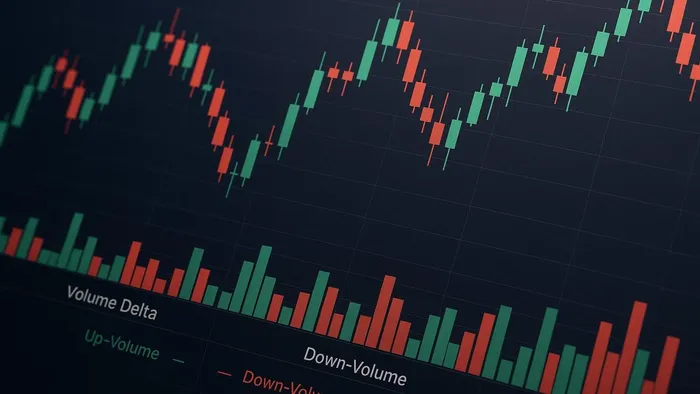Explore how the Volume Delta Indicator differentiates between buying and selling activity to enhance trading strategies and market understanding.
The Volume Delta Indicator helps traders understand market sentiment by analyzing the balance between buying (up-volume) and selling (down-volume) activity. Unlike traditional volume metrics, it separates trades into upticks (buying) and downticks (selling), offering insights into price momentum and potential trend shifts.
Key Takeaways:
- Up-Volume: Tracks buying activity. Higher up-volume signals bullish momentum, often indicating breakouts or sustained uptrends.
- Down-Volume: Tracks selling activity. Higher down-volume reflects bearish pressure, signaling potential breakdowns or reversals.
- Practical Use: Traders use these metrics to confirm trends, spot reversals, and refine entry/exit points.
- Integration: Works well with tools like RSI or moving averages to validate signals.
By combining up and down-volume, traders gain a clearer picture of market dynamics. This approach is particularly useful for identifying institutional activity and understanding the strength behind price movements.
1. Up-Volume (Buying Volume)
Definition and Calculation
Up-volume refers to the total number of shares traded when a stock’s price moves higher from one trade to the next, reflecting buying interest in the market. When a trade takes place at a price higher than the previous one, the entire trade’s volume is classified as up-volume for that session.
For instance, if Apple (AAPL) trades 1,000 shares at $150.25 after a previous trade at $150.20, those 1,000 shares are added to the up-volume count. Most modern trading platforms rely on the tick rule (classifying upticks/downticks from the last traded price) to determine up- vs. down-volume; some also compare executions to the bid–ask spread for added accuracy.
This metric is a practical tool for gauging market sentiment.
Impact on Market Sentiment
Up-volume offers a direct window into market mood, particularly bullish sentiment. When up-volume consistently surpasses down-volume, it signals that traders are willing to pay higher prices, creating upward momentum that often sustains itself.
This signal is especially useful during pivotal market moments. For example, if a stock breaks through a resistance level on heavy up-volume, it suggests institutional investors are driving the move with significant capital. On the other hand, price increases paired with weak up-volume often hint at false breakouts or rallies that may not last.
A rising up-volume can create a self-reinforcing cycle: as more buyers enter the market, confidence grows, attracting even more interest. This is why stocks with strong up-volume often experience extended upward trends, while those lacking volume support tend to stall or reverse.
Practical Applications in Trading
Traders use up-volume to identify opportunities and confirm trends. A stock showing increasing up-volume over multiple sessions while nearing a key resistance level often signals institutional buying and the potential for a breakout.
Trend confirmation is another critical use. In bull markets, healthy stocks typically show up-volume exceeding down-volume on days when prices rise. If this pattern weakens—such as when price increases are accompanied by low up-volume—it may indicate the uptrend is losing momentum and a reversal could be near.
For day traders, real-time up-volume analysis is invaluable. A surge in up-volume during the first 30 minutes of trading often points to strong institutional buying, creating opportunities for momentum trades. However, distinguishing between sustained buying pressure and temporary spikes caused by news or earnings announcements is essential for making informed decisions.
Integration with Technical Tools
Up-volume complements traditional technical analysis by adding a volume perspective to price-based indicators. For instance, a stock trading above its 50-day moving average with strong up-volume provides confirmation of bullish momentum.
It also adds context to support and resistance levels. When a stock approaches resistance with increasing up-volume, the chances of a successful breakout rise significantly. Many technical analysts look for up-volume to exceed the recent average by at least 50% to confirm breakout signals.
Combining up-volume with tools like the Relative Strength Index (RSI) can further enhance analysis. An RSI reading above 50, paired with rising up-volume, suggests bullish momentum is likely to continue. Conversely, divergences between RSI and up-volume often signal potential reversals before they become evident in price movements.
2. Down-Volume (Selling Volume)
Definition and Calculation
Down-volume refers to the shares traded on downticks, which often signal selling pressure in the market. For instance, if Tesla (TSLA) trades 2,500 shares at $245.80 after a higher-priced trade, those shares are classified as down-volume. This categorization typically follows the tick rule.
Understanding down-volume is crucial for analyzing bearish market behavior.
Impact on Market Sentiment
Down-volume provides valuable insights into bearish sentiment and selling pressure. When down-volume consistently surpasses up-volume, it indicates traders are accepting lower prices to exit positions. This behavior can lead to a self-reinforcing cycle of declining prices.
This metric becomes especially telling during periods of market stress. For example, if a stock breaks below a key support level with heavy down-volume, it might signal that institutional investors are offloading large positions. On the other hand, price declines with low down-volume often suggest temporary weakness rather than sustained selling pressure.
High down-volume tends to amplify bearish sentiment and can accelerate price drops.
Practical Applications in Trading
Traders use down-volume to identify potential reversals and confirm bearish trends. For example, when a stock shows increasing down-volume as it approaches key support levels, it often signals institutional selling and a likely breakdown of that support.
In bear markets, weakening stocks frequently display higher down-volume on declining days. A shift in this pattern—such as price drops accompanied by decreasing down-volume—can indicate that selling pressure is easing, potentially signaling a reversal.
Short sellers also rely on real-time down-volume analysis. A surge in down-volume during the market’s opening hour may highlight significant institutional selling, creating opportunities for momentum-based short trades. However, it’s important to differentiate between sustained selling pressure and temporary volume spikes caused by events like disappointing earnings or negative news.
Integration with Technical Tools
Down-volume works hand-in-hand with other technical indicators to confirm bearish trends. For instance, if a stock is trading below its 200-day moving average and shows rising down-volume, it reinforces the bearish momentum and validates the downtrend.
It also adds context to support and resistance analysis. When a stock nears a support level with rising down-volume, the chances of a breakdown increase. Analysts often look for down-volume to exceed recent averages as one of several signals confirming a breakdown.
Pairing down-volume with momentum indicators like the Moving Average Convergence Divergence (MACD) can enhance analysis. For example, a negative MACD crossover combined with rising down-volume suggests that bearish momentum is likely to continue. Conversely, divergences between MACD and down-volume patterns can hint at potential trend reversals before they become evident in price movements.
Volume Delta Indicator & Strategies
Advantages and Disadvantages
Looking at up-volume and down-volume gives us a better understanding of what makes the Volume Delta Indicator useful—and where it falls short. By breaking it down, we can see its practical strengths and its limitations.
Up-volume analysis is particularly strong at spotting real buying interest and institutional activity. When prices rise steadily alongside consistent up-volume, it often signals institutional accumulation, which is especially useful during bull markets or breakout scenarios.
However, up-volume isn’t perfect. It can miss hidden selling activity, such as iceberg orders or trades happening in dark pools. Sometimes, it even reflects retail traders chasing trends (FOMO) rather than genuine institutional buying.
Down-volume analysis shines when it comes to identifying selling pressure and market weakness. It helps detect distribution phases and can highlight periods of accelerated selling, especially in bear markets.
That said, down-volume can sometimes give a false impression of bearish sentiment. For instance, it might mistake short-term profit-taking for broader market weakness.
Both methods have shared challenges. Volume data can be skewed by factors like algorithmic trading, options expirations, or earnings season. Neither up-volume nor down-volume tells the full story on its own—they work best when paired with price movements and other technical indicators.
| Aspect | Up-Volume | Down-Volume |
|---|---|---|
| Definition | Volume traded on upticks or at ask prices | Volume traded on downticks or at bid prices |
| Market Sentiment | Reflects bullish sentiment and buying pressure | Reflects bearish sentiment and selling pressure |
| Best Use Cases | Confirming breakouts, spotting accumulation | Identifying distribution, confirming breakdowns |
| Timing Advantage | Early detection of bullish momentum | Early warning of bearish pressure |
| Primary Limitation | Can miss hidden selling activity | Can miss hidden buying activity |
| Market Environment | Works best in uptrends and consolidations | Works best in downtrends and reversals |
The Volume Delta Indicator combines these two metrics, helping to balance their individual weaknesses and provide a clearer picture of overall market sentiment.
Conclusion
Bringing everything together, the combination of up-volume and down-volume provides a fuller picture of market sentiment. On their own, each metric only tells part of the story, but together, they shed light on the forces driving price changes.
For instance, if prices are climbing but down-volume is leading, it could signal underlying weakness. On the flip side, if prices are falling but up-volume remains strong, it might indicate institutional buying is quietly taking place.
To refine your analysis, pair this indicator with tools like support and resistance levels, trend lines, or momentum signals. This layered approach can help filter out false signals and improve your timing.
Always consider the market context. During earnings seasons or major economic events, volume patterns may be skewed by factors like algorithmic trading or institutional rebalancing. In these moments, focus more on broader volume delta trends rather than reacting to short-term spikes.
Pay close attention to extreme volume delta levels. Setting alerts for these extremes can help you identify significant price moves before they happen, giving you a heads-up on potential trend changes.
Sustained shifts in volume delta often indicate larger players positioning themselves ahead of major moves. Recognizing this institutional activity can provide a valuable edge in predicting market direction.
Start by focusing on markets you’re familiar with, and observe how volume delta interacts with price changes. Over time, this practice will help you develop a sharper intuition for interpreting these signals effectively. You can also explore LuxAlgo’s AI Backtesting Assistant to prototype volume-based strategies and evaluate how different confirmation rules affect performance.
FAQs
What makes the Volume Delta Indicator different from traditional volume metrics in trading?
The Volume Delta Indicator offers a fresh perspective compared to traditional volume metrics by focusing on the net difference between aggressive buying and selling within a given time frame. Traditional volume measures the total number of shares or contracts traded, but it doesn’t reveal whether buyers or sellers are taking the lead.
The Volume Delta Indicator, on the other hand, dives deeper into market sentiment by pinpointing which side—buyers or sellers—has the upper hand. This added layer of insight helps traders gauge buying or selling pressure and better understand the forces driving price movements, ultimately supporting more informed trading decisions.
What are common mistakes traders make when analyzing up-volume and down-volume data?
One mistake traders often make is misinterpreting the relationship between volume delta and price action. This can lead to faulty predictions about market trends. To avoid these errors, it’s essential to analyze both the specific context and the broader market environment, as relying solely on one factor can result in misleading signals.
Another common misstep is ignoring the importance of volume spikes. While these spikes can indicate significant activity, they’re not always straightforward. Sometimes, they reflect moves by larger market players designed to influence retail traders. Understanding the intent behind these spikes is key to avoiding potential traps.
Finally, many traders overlook the aggressiveness of buying and selling pressure. Failing to assess the strength behind these movements can lead to misjudging volume delta data and making poor trading decisions. To ensure better accuracy, always combine volume analysis with other technical tools for a fuller perspective.
How can I use the Volume Delta Indicator with other technical tools to improve my trading strategy?
The Volume Delta Indicator becomes even more effective when paired with other technical analysis tools. By combining it with methods like moving averages, the Relative Strength Index (RSI), or the Moving Average Convergence Divergence (MACD), you can confirm trends and minimize the chances of acting on false signals.
For instance, using the Volume Delta Indicator alongside moving averages can help you better spot breakouts or reversals, giving you more confidence in your trade decisions. Adding momentum indicators such as RSI or MACD to the mix can further reveal market sentiment and trading activity. This combination of tools provides a broader perspective, making your trading strategy more precise and dependable.
References
LuxAlgo Resources
- Volume Delta Indicator
- Market Sentiment (Technicals)
- Reversal Spotting Made Easy
- Understanding Moving Averages
- Dynamic Support & Resistance
- Breakouts with Tests & Retests
- The Key to Understanding RSI
- PPF (Oscar Ramos)
- Adaptive Momentum Oscillator
- Trend Lines
- Volume Delta Candles
- Alerts Scripting: Update & Actions
- Volumetric Toolkit
- Oscillator Matrix: Reversal Signals (Docs)
- AI Backtesting Assistant








